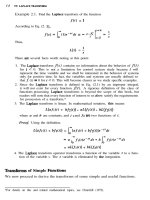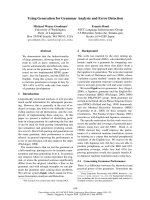LECTURE 2: PROBABILISTIC ANALYSIS AND RANDOMIZED ALGORITHMS ppt
Bạn đang xem bản rút gọn của tài liệu. Xem và tải ngay bản đầy đủ của tài liệu tại đây (154.19 KB, 14 trang )
L E C T U R E 2 : P R O B A B I L I S T I C A N A L Y S I S A N D
R A N D O M I Z E D A L G O R I T H M S
Advanced Mathematics Topics
in Computer Science
Roadmap
Sample Space and Events
Properties and Propositions
Probabilistic Analysis
The hiring problem
The hiring problem
Sample Space
Definition: The sample space S of an experiment
(whose outcome is uncertain) is the set of all possible
outcomes of the experiment.
Example (child): Determining the sex of a newborn
child in which case
child in which case
S = {boy, girl}.
Example (horse race): Assume you have an horse
race with 12 horses. If the experiment is the order of
finish in a race, then
S = {all 12! permutations of (1, 2, 3, , 11, 12)}
Events
Any subset E of the sample space S is known as an event;
i.e. an event is a set consisting of possible outcomes of
the experiment.
If the outcome of the experiment is in E, then we say that
E has occurred.
E has occurred.
Example (child): The event E = {boy} is the event that the
child is a boy.
Example (horse race): The event E = {all outcomes in S
starting with a 7} is the event that the race was won by
horse 7.
Axioms of Probability
Consider an experiment with sample space S. For each event
E, we assume that a number P (E), the probability of the event
E, is denied and satisfies the following 3 axioms.
Axiom 1
0 <= P (E) <= 1
Axiom 2
P (S) = 1
Axiom 3. For any sequence of mutually exclusive events
{E
i
}
i>=1
, i.e. E
i
intersects E
j
= Ø when i ≠ j, then
P (Union of E
i
) = Sum of P(E
i
)
Properties
Proposition: P (E
c
) = 1 - P (E) .
Proposition: If then P (E) ≤ P (F ) .
F
E
Proposition: We have P (E U F ) = P (E) + P (F ) - P
(E F ) .
Example: Matching Problem
You have n letters and n envelopes and randomly stu¤ the letters in the
envelopes. What is the probability that at least one letter will match its
intended envelope?
The sample space is the space of permutations of {1, 2, , n} and thus has
n! outcomes.
Let
Ei
=“letter
i
matches its intended envelop”. We are interested
in P (E1
Let
Ei
=“letter
i
matches its intended envelop”. We are interested
in P (E1
E2 En).
Consider the event E
i1
… E
ir
the event that each of the r letters i
1
, ,
i
r
match their intended envelopes. There are (n - r ) (n - r - 1) … 1 such
outcomes corresponding to the number of ways the remaining r envelopes
can be matched. Assuming all outcomes equi-probable, we have
P(Ei1 … Eir) = (n-r)! / n!
Matching problem (cont.)
Apply the formula in Proposition 3
Each term is equal to -1
(r+1)
x (n choose r) x (n-r)!/n!
= 1/r!
Final probability = = 1 – e
-1
when n ∞
n
r
r
r
1
1
!
1
)1(
Example: Three children with same birthday
A recent news story in the Vietnam featured a family whose three children
had all been born on the same day. But is this so remarkable?
The sample space is S = ((i , j, k) ; i in {1, , 365} , j in {1, , 365} , j in {1,
, 365}) so assuming each day is equally likely, the probability the three
days coincides is
1 / 365 x 365 ~= 7.5 / 1, 000, 000.
This is quite small but much higher that winning at the lottery.
There are 24,000,000 households in Vietnam, and 1,000,000 of them are
made up of a couple and 3 or more dependent children. Therefore we
would expect around 7 or 8 families in Vietnam to have three children all
born on the same day, and so this family is unlikely to be unique in this
country.
The hiring problem
HIRE-ASSISTANT(n)
1
best←0
candidate 0 is a least-qualified dummy candidate
2
for
i
←
1
to
n
2
for
i
←
1
to
n
3 do interview candidate i
4 if candidate i is better than candidate best
5 then best←i
6 hire candidate i
We are not concerned with the running time of
HIRE-ASSISTANT, but instead with the cost
incurred by interviewing and hiring.
Interviewing has low cost, say
c
, whereas hiring
Cost Analysis
Interviewing has low cost, say
c
i
, whereas hiring
is expensive, costing c
h
. Let m be the number of
people hired. Then the cost associated with this
algorithm is
O (nc
i
+mc
h
). No matter how many
people we hire, we always interview
n candidates
and thus always incur the cost
nc
i
, associated
with interviewing.
Worst-case analysis
In the worst case, we actually hire every candidate
that we interview. This situation occurs if the
candidates come in increasing order of quality, in
which case we hire n times, for a total hiring cost of
O
(
nc
h
).
O
(
nc
h
).
Probabilistic analysis
Probabilistic analysis is the use of probability in
the analysis of problems. In order to perform a
probabilistic analysis, we must use knowledge of the
distribution of the inputs.
For the hiring problem, we can assume that the
applicants come in a random order.
Randomized algorithm
We call an algorithm randomized if its behavior
is determined not only by its input but also by
values produced by a random-number
generator.









